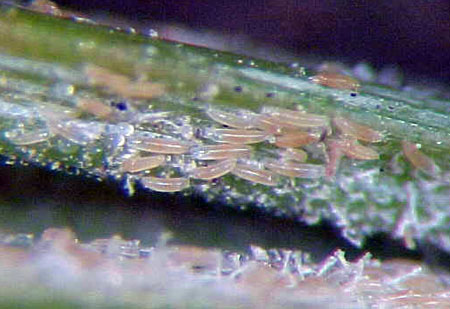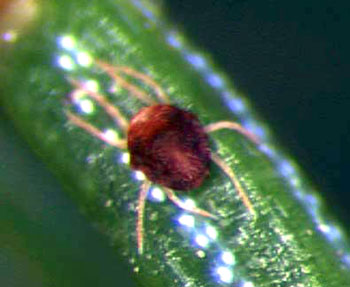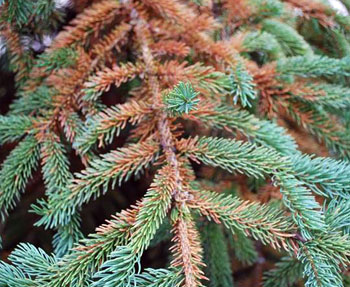Mites are becoming more active on conifers
Scouting now can help detect mite problems before their populations get large enough to cause bronzing of foliage and potentially reduce tree quality.

We are beginning to find mite populations building on several conifer species. Although the mites may be actively feeding by now, we often don’t see the bronzing damage until later in June or July. The three most common mites we find in Christmas tree plantations and on conifers in the landscape are spruce spider mites, eriophyid mites and Admes mite.
Spruce spider mites
Spruce spider mites are the most common mite found on Michigan conifers. Spruce spider mites are considered a cool season mite and thrive when daytime temperatures are in the 60s and 70s. Newly hatched larvae are pinkish in color, but turn dark green or dark red after initial feeding. This results in tiny yellow or bronze speckling on the needles. When many of these feeding spots occur near each other, the foliage takes on a yellow or bronzed cast. Once the foliage of a plant becomes bronzed, it often drops prematurely. Webbing is usually present in severe infestations. Scout the oldest foliage near the stem of the tree – that’s where the mite populations build up first.
The mites overwinter as eggs placed at the base of needles or scales. Three or more generations are produced each year at intervals of two to three weeks. The spruce spider mite is primarily a problem in the spring and fall, especially during years where severe drought conditions persist. Providing the tree with plenty of water during prolonged dry periods in the summer months will help the tree cope with mite feeding activity. Spider mite numbers also tend to build up in trees that are being crowded by other trees. Spruce trees need enough space between trees to prevent branches of different trees from touching. Hot summer temperatures cause the mite to become inactive.
Eriophyid mites
Eriophyid mites, sometimes called rust mites, have been found mainly on Black Hills and Colorado blue spruce, as well as Fraser fir in Michigan. These mites are very tiny, carrot-shaped and cream in color. In order to see them, you need at least a 15x hand lens. Even then, the insects are barely noticeable. Eriophyid mites discolor and distort foliage by feeding on the buds and needles. With these mites, we usually find the pale yellow to bronze needles on current season’s growth. Damage symptoms can be confused with other symptoms from drought, winter or herbicide injury, etc. Eriophyid mites are more of problem in commercial Christmas trees, and landscape conifers seldom have problems with eriophyid mites.

Eriophyid mites close up. Photo credit: Howard Russell, MSU Diagnostic Services
Admes mites
In past years, we have most often found Admes mites on white spruce or Black Hills spruce, but they may also be found on Colorado blue spruce and Norway spruce. They’re larger than the spruce spider mite and have a dark red or brown body with light tan legs. Their feeding can cause discoloration of the foliage. If populations are reaching damaging levels, the treatment for this pest is similar to that of spruce spider mite.


Adult Admes mite (left) damage on spruce (right). Photo credits: Rayanne Lehman, Pennsylvania Department of Agriculture, Bugwood.org (left) and Jill O’Donnell, Michigan State University Extension (right)
If you suspect mite problems, perform a foliage check. Take a piece of white paper (eriophyid mites show up best on a black background), hold it under a branch suspected of having mites, and strike the branch hard against the paper. This should dislodge the mites and even though they are very small, you should be able to see the dark, oval spider mites against the white background or the cream-colored eriophyid mites on the dark sheet. Spruce spider mites are small, about the size of a period at the end of a sentence.
If you see bronzing of the foliage or find mites when sampling, you may want to send a sample into MSU Diagnostic Services to confirm which type of mite you have.
A list of recommended insecticides for Christmas tree growers is provided by Michigan State University Extension and is available at the MSU Integrated Pest Management website.



 Print
Print Email
Email

